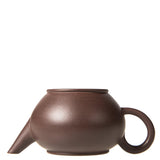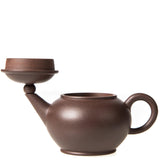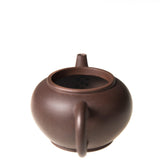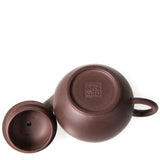A timeless design piece – the Shui Ping pot by master Gao Juntao. The pottery master crafted this model from 20-years-aged Purple Mud (老紫泥) extracted from Huang Long Shan (化黃龍山) – one of the Three Original Mines of Ding Shu, Yixing.
Aging the clay is a lengthy procedure that improves the properties of the famous purple clay and is sometimes mistaken for simple "long-term storage." It starts by putting the wet mud in a pottery tank that is not exposed to sunlight and air, and controlling the temperature and humidity.
Staying in these conditions for a certain period, the clay is fermenting, which has a pronounced beneficial effect on the mud properties. Namely, it facilitates the equal penetration and distribution of water, making the clay more homogenous. It also assists in the elimination of organic matter and increases the plasticity of the material - the clay becomes purer and more pliable. It then improves the compatibility of various components in the mud. Teapots made from aged clay get additional points for better air permeability, allowing the tea to breathe and interact with the clay. Last but not least, it accounts for a warmer, more vibrant color and a better overall look and feel of the finished product. The minimal amount of time for a lump of clay to age is twelve months, and some clays can age for as long as forty years.
Starting from the Ming dynasty onwards, "Purple mud", or Yixing Zi Ni, has the reputation of being the clay with the most sought-after properties for making teapots. It offers an optimal combination of porosity, air permeability, and high isolation properties.
The Shui Ping (水平) design is a classic teapot shape, especially loved throughout Southern China, Taiwan, Hong Kong, Macau, and Southeast Asia - the places where Gong Fu tea culture prevailed. Hui Mengchen, a pot master in the late Ming and early Qing dynasties, was the one who made this teapot design as popular as it remains today. Its functionality is based on the concept of "three dots and a line", where the spout, the lid, and the handle merge into one straight horizontal line. The design was so perfect that it almost didn't change for the next half-millennium.
Our Shui Ping teapot's rounded belly ensures enough space for bigger-leafed varieties to open up fully. It also helps concentrate the ample aroma in place for an olfactory feast.
Its classic size of 110ml is just enough to fill three to four Gong Fu cups. The wider lid makes it easy to fill or refill the pot even with big-leaf tea varieties, and the straight spout ensures a quick and steady flow of the tea soup.
Master Gao Juntao, who made this teapot, was born in Yixing – the hometown of Gong Fu Cha pottery. Inheriting a family tradition, he devoted himself to the art of purple sand from a young age. He extensively explores ancient and modern knowledge of Yixing Zisha pottery art.
• Capacity: 110ml
• Speed of pour: 12.2 ml/sec (since each teapot is individually crafted, the pouring speed may vary)
• Filter: 7 holes
• Material: Aged Huang Long Shan Zi Ni – 陈化黃龍山老紫泥
• Shape: Shui Ping (水平)
NOTE: Avoid using detergents when cleaning.









